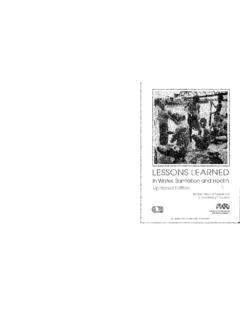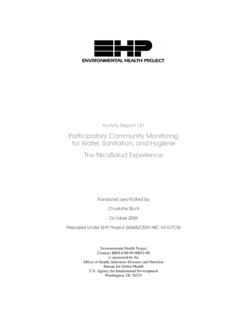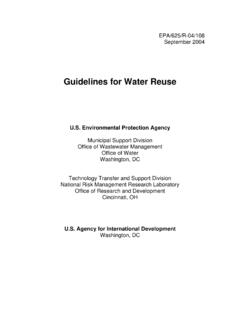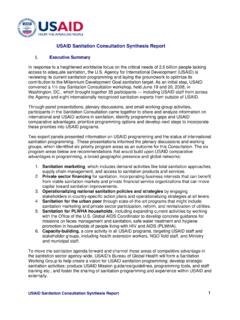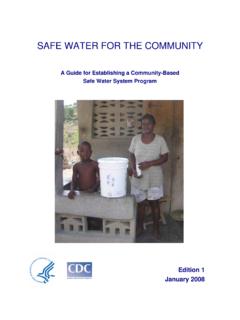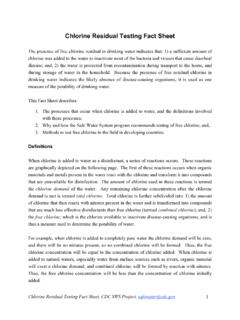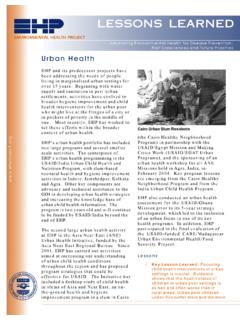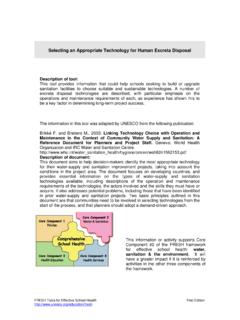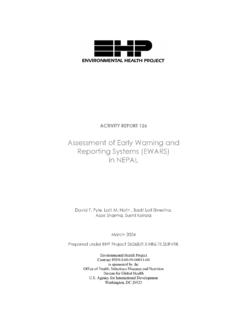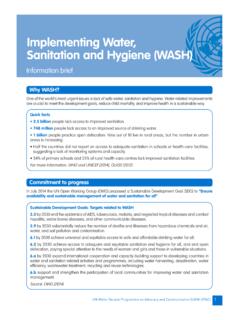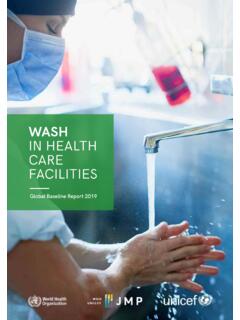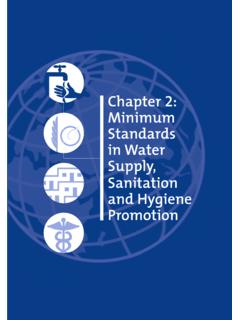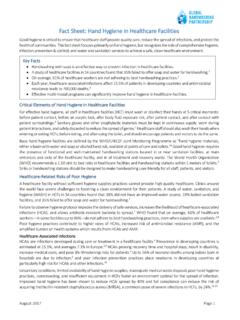Transcription of Literature review / Working document on Sanitation and ...
1 WES Section - New York HQ 1 Literature review / Working document on Sanitation and hygiene interventions December 2007 1 Introduction The number of existing publications that analyse and argue for the potential of different wash interventions to reduce the prevalence of diarrhoeal diseases is considerable and diverse. There are articles that argue for the use of interventions based on their effectiveness, their cost-benefit ratio, their cost-effectiveness, and on grounds of the soundness of their methodology.
2 WES specialists in UNICEF offices may not have the time or facilities to keep up with recent developments. With the International Year of Sanitation ahead of us this document s purpose is to provide a compilation of the recent evidence based Literature and approach based accounts for utilizing wash interventions to combat the prevalence of diarrhoea diseases in the developing world. This document focuses on hygiene and Sanitation , but also discusses water quality interventions.
3 It does not claim to be inclusive, but the presented recent evidence does have the potential to challenge current local wash strategies and hopefully results in debates about the right way of doing things in the wash sector. Firstly, section 2 discusses the effectiveness of interventions to reduce diarrhoea, where after section 3 presents the results of recent benefit-costs analysis. The following section 4 brings together recent cost-effectiveness data. Section 5 focuses on social-marketing for hand washing and Sanitation , and part 6 briefly introduces the merits of Community-Led Total Sanitation .
4 The central conclusion of this document in section 7 states the portfolio of justifications for Governments, Donors, NGO s and other partners to use wash interventions to reduce diarrhoea morbidity is substantial, but that exactly those justifications are not arguments that would drive non-compliers to start improving their health. On the contrary, instead of believing in the power of the economic rational argument, it becomes clear it is paramount to start drawing upon mechanisms that impinge on the power of a different rationality in order to trigger processes of change.
5 Methodologies that have captured this driver of change are available and have shown to be effective indeed. Annex 1 provides a categorized list of suggested readings used in the core of this document . With publications that have not been captured and new articles being published every month, the purpose of the paper requires periodical re-crafting. This document can therefore be labelled as being a Working document : with preferably input from across UNICEF offices. Your feedback on this document is highly appreciated.
6 2 2 Risk Reduction To what extent do different wash interventions actually reduce the risk for people to contract diarrhoeal diseases? A recent systematic review and meta-analysis of Fewtrell and colleagues found a strong consistency in the effectiveness of wash interventions (Fewtrell et al 2005). Chart 1 shows that all investigated interventions are effective and, moreover, hand washing with soap (HWWS) proves to be the most effective intervention to reduce diarrhoea morbidity (44%).
7 That figure supports a recent systematic review focussed on the effect of HWWS (42%) (Curtis and Cairncross 2003). Chart 1 also highlights the key role point-of-use water treatment could play in reducing diarrhoea (39%), which is even an underestimate compared to the result of a recent Cochrane review that estimates that point-of-use water treatment is as effective as HWWS (Clasen et al 2006). That review also confirms the effectiveness of household-based interventions is significantly greater than those at the source.
8 A reason for the relative low effectiveness of source water treatment interventions (11% in the chart) is the risk of microbiological contamination of drinking water during collection and storage in the home (Clasen et al 2003). A systematic meta-analysis of 22 studies measuring bacteria counts for source water and stored water in the home concludes that approximately half of the included studies identified significant contamination after water collection (Wright et al 2004). And more specifically, the decline in water quality between source and point-of-use measured in terms of faecal and total coliforms is proportionately greater where source water is largely uncontaminated (ibid.)
9 , which supports the argument for (and effectiveness of) point-of-use water treatment. Apart from contamination between the source and consumption; that water supply interventions (25%) are of less significance to reduce diarrhoea morbidity than hand washing is said to be attribute to the fact that most endemic diarrhoeal disease is not waterborne (but transmitted from person to person on hands, food and other fomites because of poor hygiene (Cairncross 2003)). One of the reasons why water supply interventions can still be quite effective is because accessible, plentiful supplies of water facilitate and encourage better hygiene in general, and more hand-washing in particular (Curtis et al 2000).
10 The large discrepancy between the effect of source and household water treatment presented in the chart and in the results of the meta-analysis of Wright et al 2005 supports that source water is often not the primary origin of diarhoeal diseases, but does stress water is nonetheless a significant transmitter of diarrhoeal diseases. Sanitation interventions are estimated to be very effective (32%). The outcome of a 2007 analysis on the effect of a city-wide Sanitation programme in northeast Brazil (Baretto et al 2007) (reduction of diarrhoea prevalence for city as a whole: 22%, and in the areas where the baseline prevalence of diarrhoea was highest: 43%) strongly subscribes to the Chart 1: Reduction in Diarrhoea Morbidity per intervention type.
